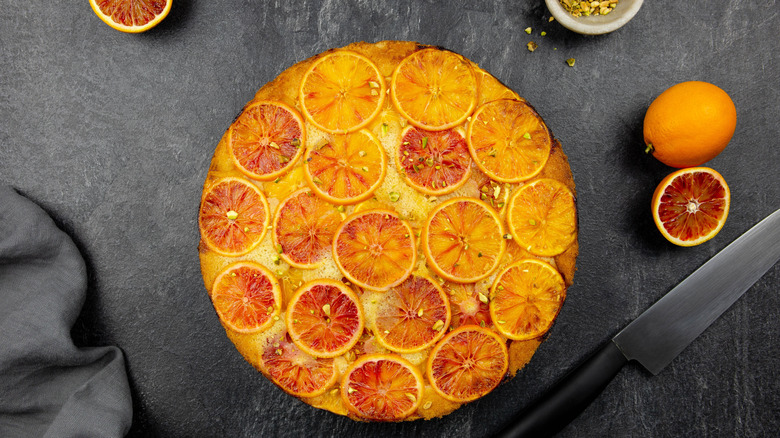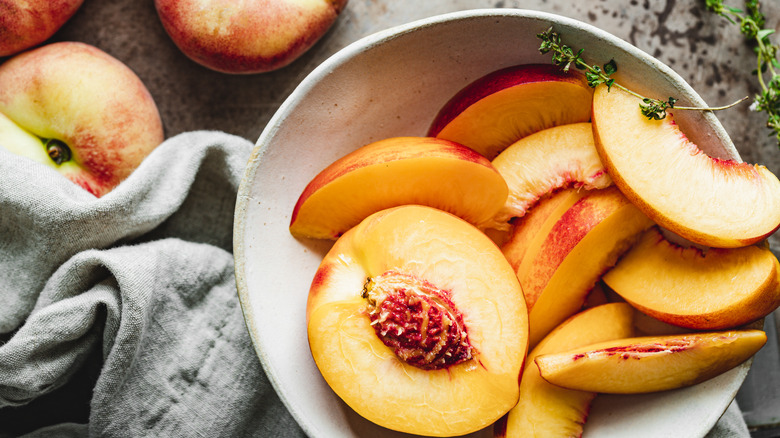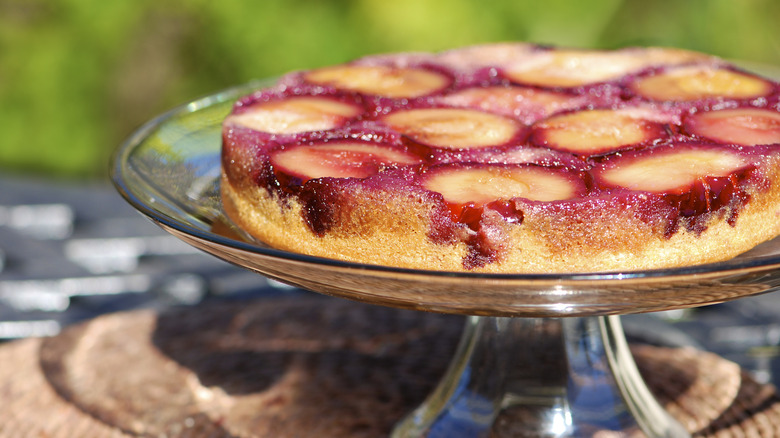The Fruit Cutting Tip That's Vital For A Perfect Upside-Down Cake
When most people hear upside-down cake, they think of the traditional American butter cake made with canned pineapple rings and maraschino cherries, baked in the bottom of the pan with a butter and sugar glaze, and flipped on its head to reveal the caramelized juicy fruit. Popularized in the 1920s (though upside-down cakes date back even further), pineapple upside-down cake is a tried-and-true staple.
The upside-down cake, like many throwbacks, is having a moment in the sun. To give the classic dessert a refresh, you can use pretty much any fruit, whether it be fresh, frozen, or canned. However, when seasonal produce is available (think: peaches in the heat of the summer, or apples and pears once the weather cools and leaves begin to fall), we recommend using it for the most flavorful cake.
When using fresh fruit, however, there is one slicing tip that's key to achieving the perfect balance of elegant simplicity while showcasing the fruit's taste: cutting the fruit in a minimum of half-inch slices. By cutting the fruit to at least this thickness, you'll avoid paper-thin cuts that really don't give the juicy bite you're looking for. Because the fruit is added to the pan, nestled within a sticky glaze, cutting it to the right thickness will ensure the fruit won't get lost or disintegrate in the gooey caramelized exterior as it bakes.
How to prepare your fruit before adding it to the pan
Unlike frosted, layered cakes, upside-down bakes rely on the cut fruit to give them a serious show-stopper appearance. While you can slice bananas, strawberries, and oranges to your fancy, this is a great opportunity to get creative with shapes and arrangements.
As long as you cut your fruit to about half-an-inch thick, you'll be on your way to ensuring the fruit's flavor and juiciness is highlighted. It is best to use fruit that's not too mushy or overripe, so it holds up and makes for clean cuts. Plus, cooking fruit is a great way to bring out the natural juices of just-under-ripe fruit. If needed, peel fruit and remove any pits. From there, you can choose to cut melon into cubes, citrus into rings, or apples into star shapes (cookie cutters work great).
Then, make a glaze using brown or granulated white sugar and melted butter, and pour it into your prepared cake pan. Place the fruit carefully on top of the glaze in any arrangement, and carefully dollop, then pour the batter on top. Bake in the oven according to your cake recipe's instructions, checking for doneness when a toothpick comes out clean. Cool the cake for a few minutes, run a knife along the inner edge between the pan and the cake, then delicately invert it to release the treat, revealing the caramelized fruit shining on top.
Flip the standard with creative cake flavors
When making upside-down cake, you can use most of your go-to cake recipes and lean into inventive flavor pairings. You'll want to use a cake recipe that can stand strong by itself, such as an olive oil or coconut cake. Pineapple upside-down cake is typically made with butter cake, which has a richness that perfectly compliments the sweetness of the fruit.
You might decide on a warm-spiced cake or pumpkin loaf to pair with apple slices and brown sugar. Have you ever tried contrasting the mouth-puckering tartness of lemons with glaze? This may just be the perfect opportunity — tossing fruit slices into your cake pan before covering them with savory lemon olive oil cake batter. You can even add fruit and glaze to the bottom of your cake pan to reimagine beloved classics, such as bananas foster or old-fashioned peach cobbler, or to give your favorite hummingbird cake recipe an upside-down twist.
Whatever flavor route you go, know that the upside-down cake is extremely customizable. You can even play around with ratios of butter to sugar in the glaze. Many bakers combine three or four tablespoons of butter with a quarter to half cup of sugar (though many classic pineapple upside-down cake recipes called for more butter and sugar). When making upside-down cake, get creative — and don't forget that the intention is really to showcase the fruit, with hearty, juicy slices.


